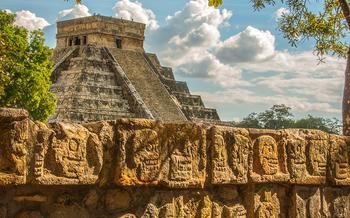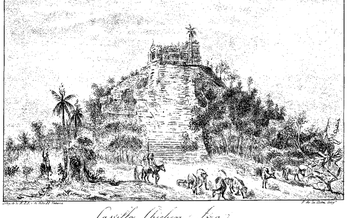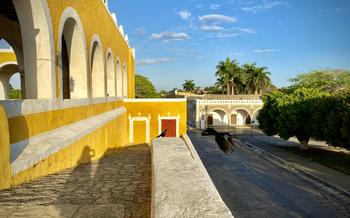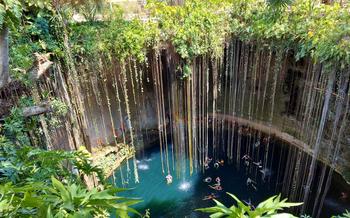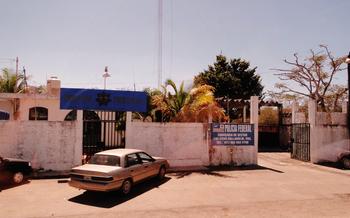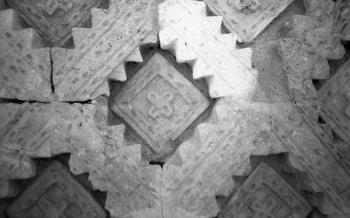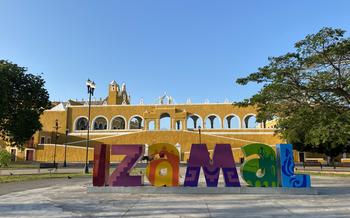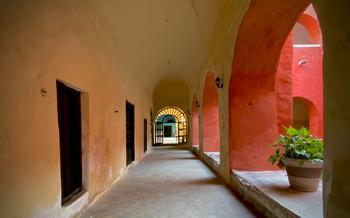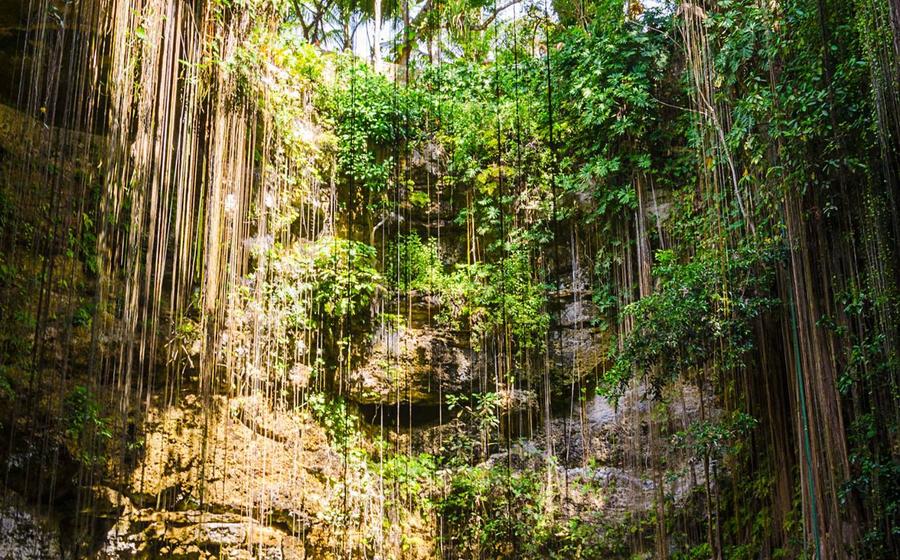
Cenote Ik Kil
- Historical Significance
- Natural Beauty
- Cultural Experiences
- Practical Information
- Cenote Ik Kil's Unique Features
- Legends and Myths
- Flora and Fauna
- Safety Precautions
- Photography and Videography
- Accessibility
- Nearby Attractions: Exploring the Yucatán's Treasures
- Local Cuisine
- Local Festivals and Events
- Insider Tip: The Secret Cave of Balamkú
Historical Significance
The ancient Maya city of Chichén Itzá, a UNESCO World Heritage Site, lies just a short distance from the Cenote Ik Kil. This sprawling metropolis, once a major center of Maya civilization, offers a fascinating glimpse into the rich history and cultural heritage of the region. Visitors can explore the iconic pyramid of El Castillo, climb the Temple of Kukulcán, and admire the intricate carvings and sculptures that adorn the city's many temples and palaces. A visit to Chichén Itzá provides a unique opportunity to learn about the advanced astronomical knowledge, architectural prowess, and cultural practices of the ancient Maya civilization.
The Cenote Ik Kil itself holds deep historical and cultural significance. For the ancient Maya, cenotes were considered sacred places, gateways to the underworld, and a source of life-giving water. The Maya believed that cenotes were inhabited by spirits and deities, and they performed rituals and ceremonies to honor these supernatural beings. Offerings, such as jade, pottery, and even human sacrifices, were often thrown into the cenotes as a way to appease the gods and ensure their favor. By exploring the Cenote Ik Kil, visitors can gain a deeper understanding of the Maya's spiritual beliefs and the role that cenotes played in their culture and religion.
In addition to Chichén Itzá, the area surrounding the Cenote Ik Kil is home to several other important Maya ruins, including the Ek Balam archaeological site. Ek Balam, which means "black jaguar" in Maya, was once a thriving city-state and a regional rival of Chichén Itzá. Visitors to Ek Balam can explore the well-preserved ruins of the city, including the Acropolis, the Ball Court, and the Temple of the Twins, and learn about the unique history and culture of this ancient Maya city.
Natural Beauty
The Cenote Ik Kil is a natural wonder that showcases the stunning beauty of the Yucatán Peninsula. Its crystal-clear waters, lush vegetation, and impressive stalactite and stalagmite formations create a breathtaking sight that leaves visitors in awe. The cenote's water is a mesmerizing shade of turquoise, reflecting the lush vegetation that surrounds it. The cenote is surrounded by a lush jungle, providing a tranquil and serene atmosphere. The towering trees and exotic flowers create a sense of seclusion and serenity, making it an ideal spot to relax and connect with nature. As you explore the cenote, you will be amazed by the intricate stalactites and stalagmites that adorn its walls and ceiling. These natural formations, created over thousands of years by the slow dripping of water, are a testament to the geological wonders of the region. The interplay of light and shadow on these formations creates a magical ambiance, making every visit to the cenote a unique and unforgettable experience.
Cultural Experiences
The cenote is not only a natural wonder but also a place of cultural significance. The Maya people considered cenotes to be sacred places and used them for various rituals and ceremonies. Visitors can participate in traditional Mayan ceremonies and rituals, such as the blessing of the cenote or the offering of flowers to the water spirits.
One of the best ways to learn about the local culture and traditions is to interact with the Maya people. Visitors can visit the nearby villages and markets to experience authentic Mexican culture. The markets are a great place to find local handicrafts, textiles, and souvenirs. Visitors can also sample delicious Yucatecan cuisine, including traditional dishes like cochinita pibil, a slow-roasted pork dish cooked in a banana leaf.
Practical Information
To make the most of your visit to Cenote Ik Kil, plan your trip during the dry season, which runs from November to April. This is when the weather is at its best, with clear skies and warm temperatures. Remember to pack comfortable shoes for walking on uneven surfaces, swimwear for taking a dip in the cenote, sunscreen to protect your skin from the tropical sun, and insect repellent to keep away pesky mosquitoes.
Transportation to the cenote is readily available from Mérida and other nearby cities. You can opt for a guided tour, which often includes round-trip transportation and additional activities, or rent a car and drive on your own. If you choose to drive, be sure to follow the signs to Cenote Ik Kil, as it is well-marked from the main roads. To enhance your experience, consider hiring a guide at the cenote. These knowledgeable individuals can provide insights into the history, culture, and geology of the cenote, making your visit even more enriching.
Cenote Ik Kil's Unique Features
Cenote Ik Kil is distinguished by its remarkable characteristics, setting it apart from other cenotes in the Yucatán Peninsula. With a depth of approximately 40 meters (130 feet), it is one of the deepest cenotes in the region. Its diameter measures an impressive 60 meters (197 feet), creating a vast and awe-inspiring natural chamber. The cenote's shape is particularly striking, featuring a vertical drop from the surface to the water's edge, surrounded by towering limestone walls.
The natural beauty of Cenote Ik Kil is captivating, thanks to its crystal-clear turquoise waters that shimmer in the sunlight. The lush vegetation surrounding the cenote adds to its allure, with tropical plants and trees draping over the cenote's rim, creating a verdant oasis in the midst of the Yucatán jungle. The cenote's stunning stalactites and stalagmites, formed over thousands of years by the dripping of mineral-rich water, further enhance its visual appeal. Visitors can admire these natural sculptures as they swim, dive, or simply relax on the cenote's platforms.
The geological processes that formed Cenote Ik Kil are fascinating. It is believed that the cenote was created when the roof of an underground cave collapsed, exposing the water table below. Over time, the cenote's walls were eroded by water, creating the vertical drop and the distinctive shape that we see today. Cenote Ik Kil's formation is a testament to the powerful forces that have shaped the Yucatán Peninsula's unique landscape.
Culturally, Cenote Ik Kil holds great significance for the ancient Mayans. It was considered a sacred site, and the Mayans believed that the cenote was a portal to the underworld. They performed religious ceremonies and rituals at the cenote, seeking guidance and protection from their gods. Today, Cenote Ik Kil remains a place of spiritual importance for many people, who visit the cenote to connect with the ancient Mayan culture and traditions.
Legends and Myths
The Cenote Ik Kil is shrouded in a veil of ancient legends and myths, adding to its allure and mystique. According to Mayan mythology, the cenote was considered a sacred place, a portal to the underworld, and a dwelling place for the rain god, Chaac. It was believed that Chaac controlled the rains and fertility, and the Mayans performed ceremonies and rituals at the cenote to appease him and ensure bountiful harvests.
One legend tells the story of a beautiful Mayan princess named Ixchel, who was chosen as a sacrifice to appease Chaac during a severe drought. Ixchel willingly jumped into the cenote, and her sacrifice brought forth the rains, saving her people from famine. She became the goddess of water and fertility, and the cenote became a sacred place of worship in her honor.
Another legend speaks of a hidden city beneath the cenote's waters, ruled by a powerful Maya king. It is said that the city is filled with treasures and riches, guarded by spirits and mystical creatures. Some believe that the cenote is a gateway to this hidden world, and that brave adventurers can find the entrance if they are pure of heart and worthy of its secrets.
Flora and Fauna
Cenote Ik Kil is home to a rich and diverse ecosystem, teeming with unique flora and fauna. The cenote's crystal-clear waters support a variety of aquatic plants, including water lilies, ferns, and algae, which provide food and shelter for a variety of fish species, such as cichlids, catfish, and bass. The surrounding lush vegetation is home to numerous bird species, including parrots, toucans, and hummingbirds, which fill the air with their vibrant songs and colors. Among the mammals that inhabit the area are spider monkeys, coatis, and raccoons, which can be spotted foraging for food or swinging through the trees. The cenote's unique environment also supports various reptiles and amphibians, including snakes, lizards, and frogs, which play a vital role in maintaining the ecosystem's balance. Preserving and protecting this delicate ecosystem is crucial to ensure the continued survival of the diverse flora and fauna that call Cenote Ik Kil home.
Safety Precautions
When visiting Cenote Ik Kil, it is essential to prioritize safety. The cenote's waters can be deep, and the slippery rocks surrounding it can pose a risk of slipping or falling. To ensure a safe and enjoyable experience, follow these safety precautions:
-
Wear a life jacket: Life jackets are mandatory for swimming in Cenote Ik Kil. They provide buoyancy and help keep you afloat, especially if you are not a strong swimmer.
-
Follow safety regulations: The cenote has safety regulations in place to protect visitors. These regulations include staying within designated swimming areas, avoiding diving from high platforms, and not climbing on the cenote's walls.
-
Avoid accidents and injuries: Be cautious when entering and exiting the cenote. Use the designated stairs or ladders, and hold onto handrails for support. Be aware of your surroundings and avoid slippery areas.
-
Lifeguards and emergency services: Lifeguards are present at the cenote to ensure the safety of visitors. They are trained to respond to emergencies and provide assistance if needed. Emergency services are also available in the area in case of any medical or safety incidents.
Photography and Videography
The beauty of Cenote Ik Kil is best captured through the lens of a camera. Whether you're a seasoned photographer or simply looking to document your travels, the cenote offers endless opportunities for stunning shots. The crystal-clear waters, lush vegetation, and dramatic rock formations create a picturesque backdrop for your photographs.
For the best results, consider using a wide-angle lens to capture the grandeur of the cenote. Experiment with different angles and perspectives to create unique and eye-catching compositions. Don't forget to look up and capture the beautiful sky, which often reflects in the water, creating a mesmerizing effect.
If you're interested in underwater photography, Cenote Ik Kil is a great place to explore. The water is clear and visibility is excellent, allowing you to capture vibrant shots of the underwater world. Be sure to bring a waterproof camera or housing to protect your equipment.
When taking photos or videos, be respectful of other visitors and avoid disturbing the natural beauty of the cenote. Follow any guidelines or restrictions regarding photography and videography, and always ask permission before photographing or filming others.
Accessibility
The Cenote Ik Kil is committed to providing a welcoming and accessible environment for all visitors. The cenote is equipped with ramps and handrails to facilitate access for visitors with disabilities. Visitors can also rent wheelchairs or strollers at the cenote's entrance. Life jackets are provided for added safety, and lifeguards are present to assist visitors.
For visitors with visual impairments, audio guides are available in several languages, providing detailed descriptions of the cenote's history, geology, and cultural significance. Braille signage is also available at various points around the cenote for easy navigation.
While the cenote is generally accessible, there are a few areas that may be challenging for visitors with mobility impairments. The stairs leading down to the cenote's platform may be difficult to navigate, and the cenote's entrance is narrow. Visitors with limited mobility may want to consider using a wheelchair or stroller to access the cenote.
Overall, the Cenote Ik Kil is a welcoming and accessible destination for visitors of all abilities. The cenote's staff is dedicated to ensuring that all visitors have a safe and enjoyable experience.
Nearby Attractions: Exploring the Yucatán's Treasures
After immersing yourself in the beauty of Cenote Ik Kil, extend your adventure by exploring other captivating destinations in the surrounding area. Discover the ancient ruins of Ek Balam, a lesser-known but equally impressive Maya city with towering pyramids, intricate carvings, and a rich history. Take a refreshing dip in Cenote X'keken, renowned for its crystal-clear waters and stunning rock formations. For a unique perspective, embark on a guided boat tour through the mangroves of the Ría Lagartos Biosphere Reserve, spotting exotic birds, crocodiles, and other wildlife. Immerse yourself in the vibrant culture of the Yucatán by visiting nearby villages and markets, where you can interact with locals, sample delicious street food, and purchase handmade crafts. Whether you seek history, nature, or cultural experiences, the Yucatán Peninsula offers an abundance of treasures waiting to be explored.
Local Cuisine
The Yucatán Peninsula is renowned for its unique and flavorful cuisine, which blends Mayan, Spanish, and Caribbean influences. When visiting Cenote Ik Kil, be sure to sample some of the local delicacies. Start your day with a traditional Yucatecan breakfast of huevos motuleños, eggs served with black beans, tomato sauce, and fried plantains. For lunch, try cochinita pibil, a slow-roasted pork dish that is considered the signature dish of the region. Make sure to accompany your meal with a refreshing glass of horchata, a sweet and creamy rice-based beverage. For dinner, indulge in panuchos, a traditional Mayan dish consisting of fried tortillas topped with black beans, shredded turkey, and pickled red onions. You can also try papadzules, a dish of corn tortillas filled with eggs and pumpkin seed sauce. Don't forget to sample the local sweets, such as marquesitas, crispy crepes filled with Edam cheese and Nutella.
Local Festivals and Events
The Yucatán Peninsula is renowned for its vibrant culture and rich traditions, which are showcased through various local festivals and events throughout the year. If you happen to visit Mérida during one of these special occasions, be sure to immerse yourself in the festivities to experience the true essence of the region. The annual Carnival celebration, held before Lent, is a riot of color, music, and dance, featuring elaborate parades, costume contests, and traditional Yucatecan cuisine. Another must-attend event is the Hanal Pixán, or Day of the Dead, when families honor their deceased loved ones by building colorful altars adorned with offerings, flowers, and candles. For a unique cultural experience, visit the town of Valladolid during the Festival de las Ánimas (Festival of Souls), where locals participate in a candlelit procession to the cenote Zaci, paying homage to the spirits of the departed.
Insider Tip: The Secret Cave of Balamkú
For an unforgettable experience, venture off the beaten path and discover the hidden cave of Balamkú, located just a short distance from Cenote Ik Kil. Immerse yourself in the mystical atmosphere of this ancient cave, adorned with impressive stalactites and stalagmites. With its secluded location and tranquil ambiance, Balamkú offers a unique opportunity to connect with nature and history. Explore the cave's chambers, marvel at its natural formations, and let your imagination soar as you uncover the secrets of this hidden gem.
